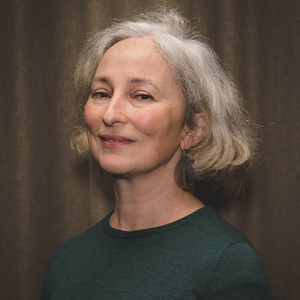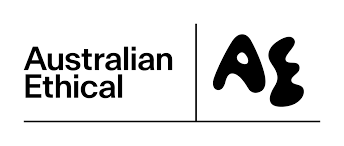The Life You Can Save
2022 Annual Report
A Note From Our Executive Director
At The Life You Can Save, our mission is to fight extreme poverty by researching and identifying highly impactful charities serving the global poor, and fundraising to support their work. We want to make it easy for people who care about global poverty to give with confidence that their donation will make a real difference.
In 2022, we pursued this mission by growing our team at The Life You Can Save and making strategic long-term investments in our operations. We created and filled several new positions, including Director of Partnerships and Director of Public Relations, that will help us continue to raise our profile, expand our network of supporters and, most importantly, increase effective giving around the world. We established a new Director of Philanthropy, continued to refine our charity evaluation framework and launched our new Cause Funds — all with the goal of helping donors give more confidently and more effectively. And, in addition to strengthening our own organizational capacity, we collaborated with other mission-aligned organizations on several exciting initiatives, including the publication of a German translation of The Life You Can Save in partnership with Effektiv Spenden.
2022 was not without its challenges. While we raised $18.1 million for our recommended charities in 2022, this was the first time since our founding in 2013 that our overall Money Moved metric declined on an annual basis. This decline was driven by several of our largest donors not renewing their contributions or contributing at the same level. Some of these donors told us that poor financial market performance, particularly in tech stocks, hurt their giving capacity in 2022. We don’t believe our experience is unique, as other nonprofits in the effective giving community have reported similar conversations with their large donors.
Despite these challenges, we saw many promising trends:
- While our overall Money Moved was down, we saw a slight increase in the average individual donation amount processed through The Life You Can Save’s platforms. This suggests that donors appreciate the suite of giving options we provide, including our new Cause Funds.
- Our Australian organization continues to show strength, with donations growing 26% in Australian dollar terms (though a weakening Australian dollar limited the extent to which this growth flowed through to our US dollar impact).
- Our three-year Leverage Ratio, the metric we use to measure our ability to multiply your donation’s impact, remained strong at 15x, and our consistent performance over time has recently led the Founders Pledge to endorse our organization as a “very high (gross) multiplier.”
In closing, I want to announce that my personal role at The Life You Can Save will be changing going forward. After a fantastic six-year journey with The Life You Can Save — from volunteer to Executive Director — it’s time for me to start working on what’s next, and I’ll therefore be stepping down from the Executive Director position. I’m thrilled to remain on the board of The Life You Can Save Australia and continue actively working with the team, donors, partners and collaborators to further the organization’s mission. Our co-founder Charlie Bresler will be stepping in as our interim Executive Director while our search committee looks for the right person to lead our organization in its next chapter.
I’m so grateful for our amazing network of donors and supporters. Thank you so much for another exciting and impactful year.

Rickard Vikström
Executive Director of The Life You Can Save
*All dollar ($) amounts specified in this report are United States dollar amounts unless expressly indicated otherwise.


The Year In Numbers
| Metric | 2022 | 2021 | 1 yr % Change | Compound annual growth since 2014 |
| Net Impact | $16,334,317 | $21,395,494 | -24% | 51% |
| Money Moved | $18,066,477 | $22,680,019 | -20% | 47% |
| Money Moved ex large outlier donations | $18,066,477 | $18,471,578 | -2% | 47% |
| Expenses | $1,732,160 | $1,284,525 | 35% | 30% |
Net Impact: We measure our Net Impact by subtracting our total annual expenses from the total Money Moved to our recommended nonprofits. In 2022, our net impact was ~$16.3 million as we spent ~$1.7 million on our operations globally and raised ~$18.1 million for our recommended nonprofits.
Money Moved: In 2022, our supporters donated a total of ~$18.1 million to our recommended charities.
Money Moved excluding large outlier donations: The giving levels of one or a few large donors in any given year can have a significant impact on our overall results, and these donations can also be quite volatile year-to-year. We, therefore, report on both the total Money Moved and “Money Moved excluding large outlier donations” to help indicate our growth rate. We had none of these large outlier donations in 2022, whereas we had $4.2 million in 2021. Most of the decline in money moved we experienced last year is attributable to these large 2021 gifts not recurring in 2022.
Expenses: Expenses grew to $1.7 million in 2022 as we made significant investments in our team and infrastructure, adding needed capacity and building scalable systems. Our most notable additions were our Director of Partnerships and Director of Public Relations.
3-year leverage ratio: If you take all the money we raise annually for our nonprofits and divide that number by the money we spend operating our organization, you get what we call our “leverage ratio” for that year. To gauge our impact over time, we rely on a “3-year leverage ratio“ which is simply our average annual leverage ratio over the past three years.
From 2020-2022, our 3-year leverage ratio was 15:1. In other words, for every $1 we invested in spreading our message and helping others discover and donate to effective charities over the last three years, we raised $15 for our recommended nonprofits. We believe our 3-year leverage ratio is a helpful representation of our effectiveness and impact. But we also believe this estimate is fairly conservative since we’re unable to track all the donations that would ideally be included in our overall Money Moved metric. (See the Appendix of this report for more details on the donations that are more difficult to track.)
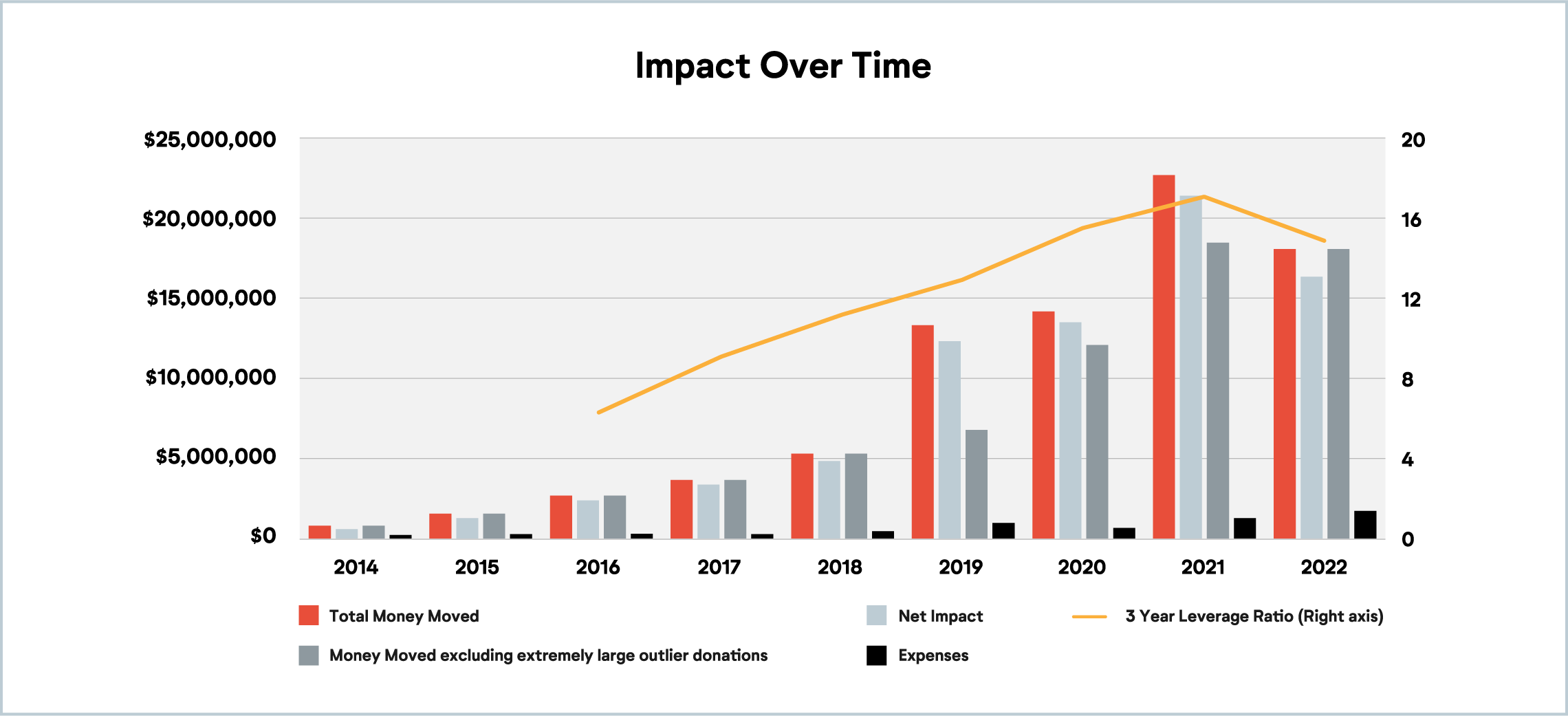
CHANGING THE CULTURE OF GIVING
A Key Moment in the Fight Against Poverty
By Peter Singer
2022 was a tumultuous year for global efforts to reduce extreme poverty. In a recent report entitled Poverty and Shared Prosperity 2022: Correcting Course, analysts from the World Bank detail what they rightly call a “historic shock” to poverty reduction efforts in the wake of the Covid-19 pandemic. As many know, after decades of steady decline the number of people living below the extreme poverty line rose by over 70 million in 2020. Global income inequality also significantly increased, exacerbated by uneven economic recovery from the pandemic.
Other global crises in 2022 — especially catastrophic climate events and conflicts in major food producing regions like Ukraine — have slowed the global recovery from the pandemic and contributed to rising costs of food and energy worldwide. Given these difficult trends, the United Nation’s ambitious goal of ending extreme poverty by 2030 looks unlikely to be reached.
Despite these setbacks, it’s important not to lose sight of the incredible progress we have made over the last few decades towards the goal of ending extreme poverty. The World Bank predicts that in 2030 nearly 7% of the world’s population, or roughly 574 million people, will still live in extreme poverty, now defined as less than US$2.15 a day. That is, of course, far from ideal, but in 1990, both that percentage and the absolute number of people living in extreme poverty were much higher: nearly 36% of the world’s population, or 1.6 billion people.
It is vital that in the coming years, we can regroup and overcome the challenges we face today. These new challenges make the work of promoting effective giving and supporting high-impact charities more critical than ever. In this section, we highlight some of the ways The Life You Can Save is working to create a new culture of effective giving with easy-to-use tools, fundraising and publicity campaigns and partnerships with mission-aligned organizations.
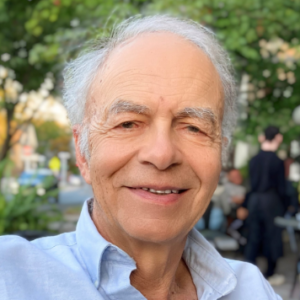
Peter Singer
Founder
CHANGING THE CULTURE OF GIVING
Bringing Our Message to New Audiences
To truly change the culture of giving, we need to spread the effective giving message to new audiences and geographies.
In 2022, with the help of a few of our amazing partners, we made significant progress toward this goal.
At the end of 2022, we partnered with our friends at Effektiv Spenden to publish a German translation of our book, The Life You Can Save, just in time for the German giving season. This German translation is now available in print, ebook and audiobook formats, across all major platforms.
In the first three and a half months since the launch of the German translation, Effektiv Spenden has distributed more than 1,300 copies through sales and partners. And that’s not all: our partners at Berlin-based Blinkist created a German “Blink” —or 15-minute summary— of The Life You Can Save, promoted it to all of their German speaking users, and inspired 7,000 unique downloads of the German Blink.
In 2022 we also promoted the Hindi translation of our book at the Ashoka Literature Festival, and we worked with Give, India’s largest and most trusted giving platform, to promote our message among Indian donors. Our India page highlights our recommended charities that are currently operating in India, and we hope to expand this list in the near future.
In 2023, we look forward to promoting these new publications and pursuing new opportunities to spread the book’s message around the world.

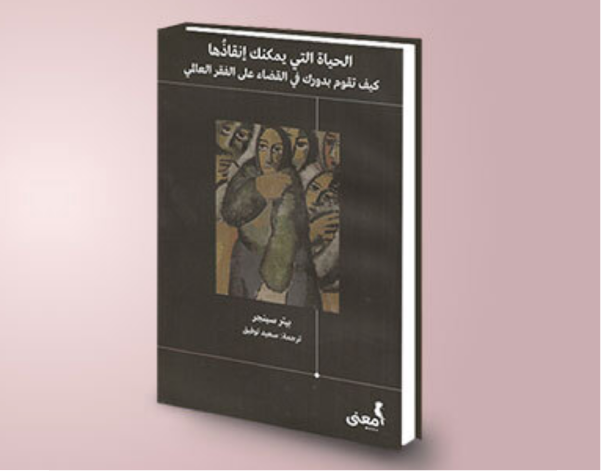
CHANGING THE CULTURE OF GIVING
Leveraging the Power of Media
Mass media is invaluable as we seek to educate new audiences about effective giving. In 2022, we significantly increased The Life You Can Save’s media presence and received features in over five dozen media outlets, including high-profile publications like The Australian Financial Review, The Daily Stoic Podcast, The Los Angeles Times and more.
In 2022 you helped us distribute
(full and abridged versions)
An update from our Research Team:
In 2022, our Research & Evaluation Team at The Life You Can Save had the opportunity to grow and develop. We finalized and published our charity evaluation framework in August, after extensive consideration and feedback with key stakeholders. This framework will help us continue to expand our recommendations for excellent giving opportunities and optimize our grant allocations.
In October, Matias Nestore and Anna Demant joined our team. We launched our new cause funds in November, which allow donors to give to several high-impact charities at once with a single donation. In the coming year, we plan to offer several new charity recommendations focused on education, emergency relief and mental health on the basis of our in-house research and the expertise of our many trusted partners and advisors.

Katie Stanford
Research Manager
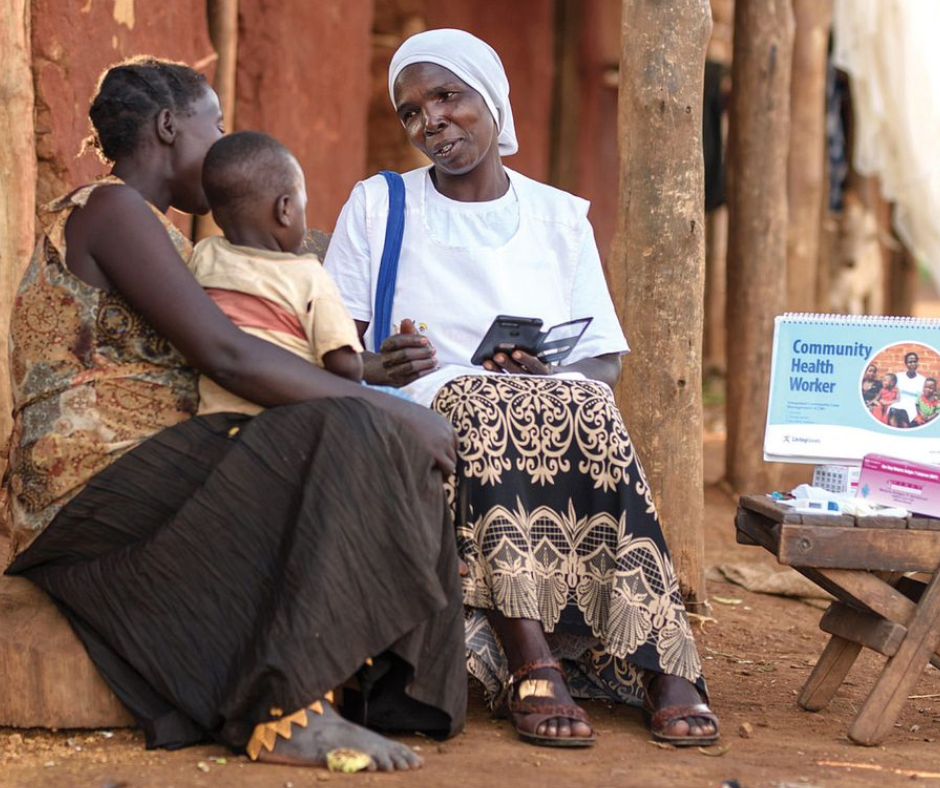
FINDING AND SUPPORTING EFFECTIVE CHARITIES
Spreading the Effective Giving Message
By Charlie Bresler: As I move back into my former role as Executive Director until we complete our search for a new one, I want to take this opportunity to thank Rickard Vikström for his six years of excellent service, which have left The Life You Can Save a stronger organization. Rickard’s “built-to-scale initiative” has improved our systems, processes, goal setting, and budgeting process. I am very glad that in spite of his decision to move on, Rickard has agreed to remain a Board member of our Australian entity. I also want to take this opportunity to highlight a couple of initiatives we began in 2022 that I’m especially excited about as we look ahead to 2023 and beyond.
For some time, I’ve wanted to start a podcast. I wanted to learn more about how the individuals I interview — many of them quite wealthy and well connected — view their obligation to share their good fortune with others, even strangers, and how they navigate the challenge of providing for their family, supporting their local communities and giving beyond their own personal networks. In 2022, we were fortunate enough to lay the groundwork for this series and secure our first interviews, and we hope to launch the full series later this year.
This podcast series is a part of our ongoing efforts to connect with more high-net-worth and ultra-high-net-worth individuals both inside and outside the effective altruism ecosystem. Of course, we are focused on reaching all types of donors. But donations from high-net-worth and ultra-high-net-worth individuals can have a dramatic impact on the amount we can invest in things like marketing and partnerships, which ultimately help us raise more money for our recommended nonprofits. Simply put, we need high-net-worth individuals to help us build a powerful engine capable of reaching a mass audience of donors.
To take just one example of how this engine can work, thanks to your support, last year we were able to grow our team enough to experiment with more customized direct marketing campaigns than ever before. In one especially successful direct mail campaign, we contacted past supporters who had not donated in two years. It was a simple, low-cost effort that resulted in a spectacular return on investment of over 4000% on the cost of the mailing, and a model for the kind of campaigns we hope to continue in 2023.
I look forward to working closely with the Team to continue our mission, while still making time for my granddaughters, children and, not least, my wife Diana, with whom I will be celebrating 50 amazing years together this May.

Do Good, Feel Good.
Charlie Bresler
Co-Founder and Board Member
FINDING AND SUPPORTING EFFECTIVE CHARITIES
Furthering Our Cause with the Help of Amazing Partners
Partnerships are an essential part of our work promoting effective giving. We’re lucky to work with a generous roster of partners who use their talents, networks and businesses to help people in extreme poverty. We’ve already shared some of the work we’ve done with partners to promote our book and reach new audiences, but in this section we want to highlight a few more exciting partnerships and explain our Partnerships strategy.
We began a partnership in 2022 with Fluffy Torpedo, a fine ice cream shop in Melbourne. They donate A$ 50c per scoop to The Life You Can Save’s operations, our logo is on the door and they distribute copies of the book to their customers, who are often lined up out the door. We are very grateful for this opportunity and have been delighted by the positive response.
Our Partnerships strategy is not only focused on acquiring and creating new alliances, but also on continuing and reinventing our existing collaborations to achieve even greater impact through them. In 2022, our long-time partner Give Industries — an Australian social enterprise that offers high quality, sustainable electrical services and donates all of its profits to charities — chose to donate more than A$125,000 of its profits to our recommended nonprofits. We are delighted to see their altruistic business model succeeding and doing so much for those in dire need. They are a real example of how businesses can save and improve real lives by embracing effective giving.
2022 also marked the third anniversary of Kate Tapping’s Write The World project, which produces gorgeous notebooks and sells them to raise money to tackle issues around global poverty. The notebooks are sold for A$10, which is donated in full to effective charities recommended by The Life You Can Save. To date, this amazing project has raised over A$111,000.
Find out more about our amazing network of Partners, Supporters and Collaborators.
FINDING AND SUPPORTING EFFECTIVE CHARITIES
Stories of Impact
Sanku – Project Healthy Children
Closing the gap on maize flour fortification
Ruth Awuor, owner of Grainora Mill in Nairobi, Kenya, recently partnered with Sanku to provide over 75,000 people with flour that contains lifesaving vitamins and minerals. As a part of her partnership, Ruth was invited to represent Kenyan small and medium millers during the World Economic Forum at Davos. Sanku aims to reach 100 million people with nutritious food by 2030 by providing millers like Ruth with the necessary tools to fortify their flour. Learn more about Sanku.
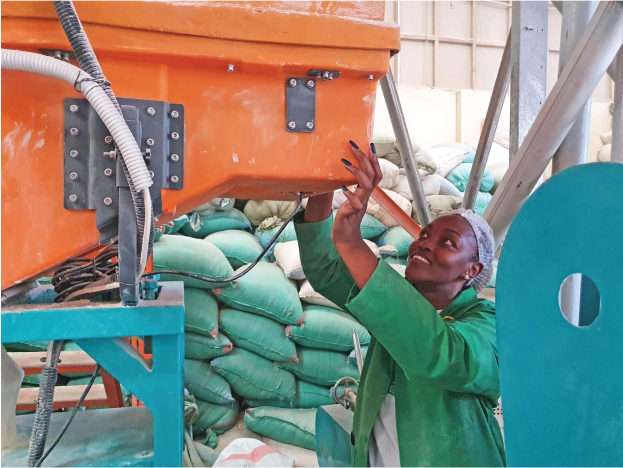
“Thanks to Sanku’s fortification technology, our flour is nutritious. We are better, and our customers are happy.”
– Ruth Awuor, at her mill in Nairobi, Kenya
New Incentives
Khadija is just one of 627,820 other caregivers in Nigeria who enrolled her child with New Incentives’ program designed to promote life-saving vaccinations. Children in Nigeria are 18x less likely to reach their 5th birthday than their peers in the US and 30x less likely than their peers in Australia — often because they have not been vaccinated against deadly but preventable diseases. Now, Khadija receives small cash incentives to bring her son to a clinic six times over 15 months to receive his routine childhood vaccines and, as she emphasizes, “protect him from deadly diseases.” Learn how you can help children thrive through New Incentives’ impactful programming here.
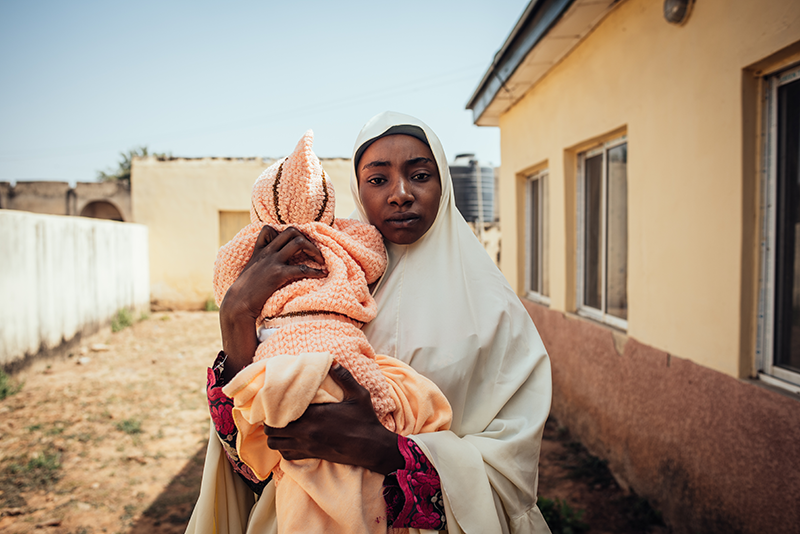
Charity: New Incentives
Get in Touch
Get in touch with Emily for general questions or with Charlie, Louise or Rickard for advice on large donations.
CONTINUING OUR MISSION AND INCREASING OUR IMPACT
The Impact our Donors Can Achieve
By Neela Saldanha: While I enjoy my cup of coffee, it is sobering to think that 700 million people live on less per day than what I paid for it. Less than $2.15 per day, to be precise, is the extremely low standard for global poverty, according to the latest estimates from the World Bank. But we don’t have to live with this situation, we can all change it. And even better, we can do it without leaving our homes and by sharing something we may have that is precious for committed organizations: money.
At The Life We Can Save, we want to reach as many people with the message to give to effective charities. In fact, I’ll be ambitious and say it: we want to reach everyone in the world who has some spare cash to donate! When millions of our fellow human beings live in miserable conditions, we can’t afford to do otherwise. But we also understand the hesitation people have about potentially wasting their hard-earned money supporting bad or ineffective charities. To make it easier, we therefore recommend a small set of effective non-profits that we are confident have measurable impact.
This work takes time. And yes, money. To research effective organizations. To print and deliver the book and its message to people (the book itself is free). To reach people like our inspiring partners. To run campaigns that compete for attention with the latest fun TikTok trend. And to do all the things we need to do to ensure careful stewardship of our donors’ funds: strong systems and processes with investments in finance, risk, IT and operations.
We don’t take any part of the donations to our recommended non-profits to fund our own operations. And our dedicated donors have helped us defray costs of our lean operations so far. But we want to grow the message even more. And that requires more funds.
So we would like to ask you to consider donating, if you have not already, to The Life You Can Save. If you have already, thank you and know that every $1 you have donated to The Life You Can Save has raised $15 for our effective non-profits.
If you would like to donate to The Life You Can Save’s operations, you can do so using the buttons below or by “adding a tip” when you donate to our recommended charities or cause funds through our website.
Thank you for every contribution and enjoy your coffee!

Neela Saldanha
Board Member, The Life You Can Save
Executive Director, Yale Research Initiative on Innovation & Scale (Y-RISE)
Thank you to the more than 3000 donors
who helped fund our operations in 2022.
Donate to The Life You Can Save
Other ways to donate:
We recommend that gifts up to $1,000 be made online by credit card (use the ‘Donate to The Life You Can Save’ button above).
If you are giving more than $1,000, please consider one of these alternative ways to donate.
Get in Touch
Contact us or leave a comment or question
Thank You!
Your message has been received and we will contact you soon.
APPENDIX
Our Key Metrics: Net Impact and Leverage Ratio
The main metrics we use to assess our performance are our “Net Impact” and our “Leverage Ratio.”
Our “Net Impact” takes the money we raise (i.e. our “Money Moved”) and subtracts our operational expenses from that figure. Our “Leverage Ratio,” by comparison, takes our Money Moved and divides that number by our expenses. We typically talk about our Leverage Ratio in terms of a three-year period (money moved over three years divided by expenses over three years) as it can be rather volatile over a one-year period.
Both of these metrics compare the amount of money we raise for our nonprofits to the money we spend operating our organization. We believe both of these metrics are important and are ideally looked at together rather than in isolation. However, we believe our Net Impact is a more important single measure than our Money Moved because it captures our absolute impact, which translates into real-world impact on the lives of people living in extreme poverty. As such, our primary goal is to maximize our Net Impact while maintaining a reasonable three-year Leverage Ratio.
To use an extreme example, given the choice, we would much rather be an organization that moved $100 million to our recommended charities and spent $10 million to do so (in which case we’d have a Net Impact of $90 million and a Leverage Ratio of 10:1) than an organization that moved $100 and spent $1 to do so (which would give us a Net Impact of $99 and a Leverage Ratio of 100:1). In the latter scenario, our work would be highly efficient but wouldn’t necessarily lead to much real world impact. That said, we believe our Leverage Ratio (which we also refer to as our “Multiplier”) is an important metric because it captures the efficiency of our operations. And we recognize that our Leverage Ratio is an intuitive and meaningful metric for many supporters who donate to fund our operations, one that helps supporters understand the “multiplier” they get on their gift. For instance, by applying our 3-year Leverage Ratio of 15:1 to a gift of $1,000, a donor could expect that donation to help us raise ~$15,000 for our recommended nonprofits.
We believe that both Net Impact and Leverage Ratio are conservative measures of our impact. This is because we know the Money Moved metric used to calculate both metrics doesn’t account for all the donations we may have inspired. While we can measure donations that flow through The Life You Can Save, our ability to track donations that we influence that are made directly to our recommended nonprofits is much more limited. We rely on our nonprofits to track those donations, and many of our nonprofits have limited ability to do so. A donor survey we send out helps fill some, but not all, of the gaps in our data. We’re confident that we’re still missing some donations made directly to our nonprofits. We’re also confident that we’re undercounting donations that we influence where foreign donors give through intermediaries that allow them to claim tax relief.
Even if we could perfectly measure donations made to our recommended nonprofits, our key metrics would still understate our impact. They assign no value to donations that we influence to effective nonprofits that aren’t on our list of recommendations, and they don’t capture non-monetary influence like motivating people to use their careers for social good.
The Life You Can Save Financials 2022
View financial information here.
Money Moved 2022 – What’s Included?
In this section of the Annual Report, we provide a detailed account of our total “Money Moved” (i.e. the total donations to our recommended nonprofits that we either processed directly or inspired) and our operating expenses. We view these figures as a helpful supplement to the standard regulatory reporting measures commonly used to conduct financial analyses of nonprofits (ex. the Form 990 in the US and statements filed with the ACNC in Australia).
Please note that the figures provided in this Annual Report may at times differ from those provided in official financial records for a few reasons:
- Global results vs. National Results: In our Annual Report, we aggregate the money moved and operating expenses of The Life You Can Save (a US-based nonprofit) and The Life You Can Save Australia (which is a registered charity in Australia) in order to assess our overall global impact. Technically speaking, however, “The Life You Can Save (US)” and “The Life You Can Save Australia” are separate legal entities subject to different reporting requirements imposed by their respective jurisdictions. As such, their official records will be separate.
- Revenue for our recommended charities vs. Revenue for The Life You Can Save itself: Our official income statements include two different types of donations we receive: 1) donations given to The Life You Can Save itself for our own operational expenses and 2) donations made through The Life You Can Save and granted by us to one or more of our recommended nonprofits. Our grants are officially recorded as “expenses” and “program costs” in our financial statements in the US and Australia respectively, but to best understand our financial status, it’s important to distinguish between this granting activity and our operational spending.
- Donations processed vs Donations influenced: When calculating our total Money Moved to our recommended charities, we include both donations that we process directly as grants and donations to our charities (either directly or through a third party such as Network for Good or other intermediaries) that our outreach inspired or influenced in some way. Since our official financial statements only record funds directly processed by our own organization, they reflect most, but not all, of our total Money Moved.
We also made one change in 2022 that should reduce discrepancies between the figures in our Annual Report and those in our official financial records. Prior to 2022, we measured our money moved on a “metric year” basis, which runs from February through January. We used this metric year convention because January donations are largely related to the year-end “giving season,” and as such metric years often provide a more meaningful picture of our annual performance. However, in 2022 we abandoned our use of the metric year, as we felt the complication it added outweighed the benefits. Now our performance results and official financial reports are both calculated on a calendar year basis.
For stakeholders interested in reconciling the figures in this Annual Report with those provided in our official financial records, this document and this table offer additional details.
Money Moved 2022 – by Charity
This table provides a representative snapshot of the Money Moved — or amounts raised — for each of our recommended charities in 2022. The table excludes donations made by foundations and individuals who have requested that the designation of their contributions remain confidential.
The Life You Can Save Operational Income – by Source
The chart and table below illustrate the sources of income for The Life You Can Save’s operational expenses. We’ve prioritized achieving a healthy breadth and diversity of revenue streams in recent years, and we believe our funding sources reflect that priority. Note: The data below aggregates income for The Life You Can Save US and The Life You Can Save Australia.
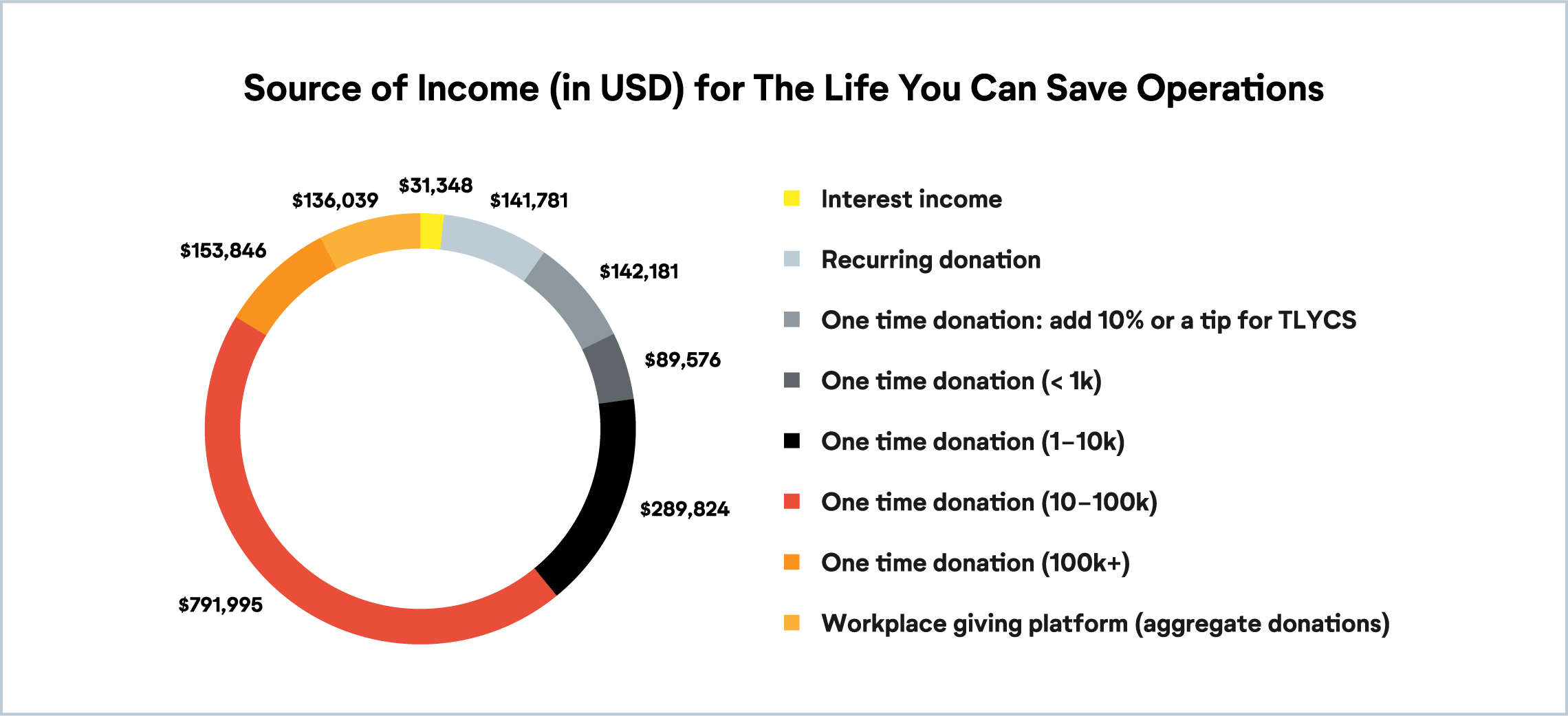
|
Type of donation |
USD Revenue |
# of Donors |
# of Donors >=$10 |
|
Interest income |
$31,348 |
– |
– |
|
Recurring donation |
$141,781 |
1,023 |
892 |
|
One time donation: add 10% or a tip for TLYCS |
$142,181 |
1,604 |
1,133 |
|
One time donation (< 1k) |
$89,576 |
710 |
543 |
|
One time donation (1-10k) |
$289,824 |
92 |
92 |
|
One time donation (10-100k) |
$791,995 |
30 |
30 |
|
One time donation (100k+) |
$153,846 |
1 |
1 |
2020 Reporting Error Corrected
In late 2022, we discovered a reporting error in our 2020 performance metrics in which a single large donation was miscounted. Importantly, this was only a clerical error; no money was lost. But it did cause us to significantly overstate the money we moved to our recommended nonprofits in 2020 and also impacted some metrics in the 2021 Annual Report. This error occurred because we received some donation data with ambiguous data labels from one of our partners and did not sufficiently clarify exactly what was represented in that data set. We deeply regret the error and have since updated our 2020 and 2021 Annual Reports, and have also implemented process improvements to prevent similar errors in the future. More details can be found in this blog post. The numbers in this 2022 Annual Report were not affected by this reporting error.







